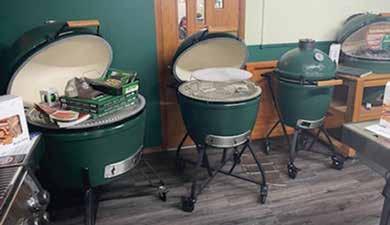














It’s no surprise to anyone who lives on a lake or near a lake community that the busiest time of the year for America’s recreational boat owners is, hands down, during the summer months. Through Labor Day weekend and beyond – depending on the weather – many people will continue to spend time on the water.
In addition to taking a cruise around the lake, a lot of boaters enjoy spending a day or two at anchor, enjoying fishing holes, raft-ups, and swimming. Any of those activities are suitable for enjoying time with family and friends, especially as summer winds down.
Anchoring is quite popular on many lakes, and the BoatUS Foundation for Boating Safety and Clean Water offers the following tips to help boaters spend time on the water safely while doing so.
Before heading out, make sure your anchoring gear is up to snuff, including that the bitter end is secured. You may not have used it yet this boating season, so be sure all is good to go for whatever anchoring arrangement – whether a picnic hook, extra fenders for a raft-up, or shoreside tie-up requiring a second line.
When arriving to your gathering spot and setting anchor, ensure you let out enough scope for the depth and predicted weather conditions.
Show some courtesy if things get crowded. On the other hand, don’t be that guy who runs into an anchorage throwing a wake or is completely oblivious to those around him.
Generators give boaters the creature comforts they want. However, don’t run the generator if you’ve got swimmers in the water at the back of the boat – a common place for guests to congregate on floats and pool toys.
The rear of the boat is where exhaust

ports are often located, spewing dangerous, odorless carbon monoxide.
Anchoring tends to be a long day on the water. Be careful with stressors, including noise, vibration, sun, wind, waves, and other motion.
U.S. Coast Guard research shows that four hours of exposure to any of the above can produce a kind of fatigue referred to as “boater ’s hypnosis.” It’s known to slow peoples’ reaction time almost as much as if they were legally drunk. And for those who do choose to partake, adding alcohol makes it worse.
Also important, don’t stress the boat battery playing music all day. TowBoatUS reports calls to its 24-hour dispatch for battery jump services surge – as if on cue –at the end of the day when boaters want to head home.
Before departing an anchorage, wait to turn on the engine until everyone is securely aboard and the ladder is up. When in an area crowded with other boats and
people, proceed with the utmost caution. It’s always better to wait a few minutes for everyone to clear out and give a chance for wakes to subside before departing.
Be patient and, again, give as much courtesy as you can. Everyone aboard should be acting as a lookout. Also, never take a shortcut home after dark.
The BoatUS Foundation for Boating Safety and Clean Water is a national leader promoting safe, clean, and responsible boating.
Funded primarily by donations from the nearly 800,000 members of Boat Owners Association of The United States (BoatUS), the nonprofit provides innovative educational outreach directly to boaters and anglers with the aim of reducing accidents and fatalities, increasing stewardship of America’s waterways, and keeping boating safe for all.
A range of safe and clean boating courses – including the nation’s largest free online boating safety course – can be found on the foundation’s website.
For more information, visit boatus.org.
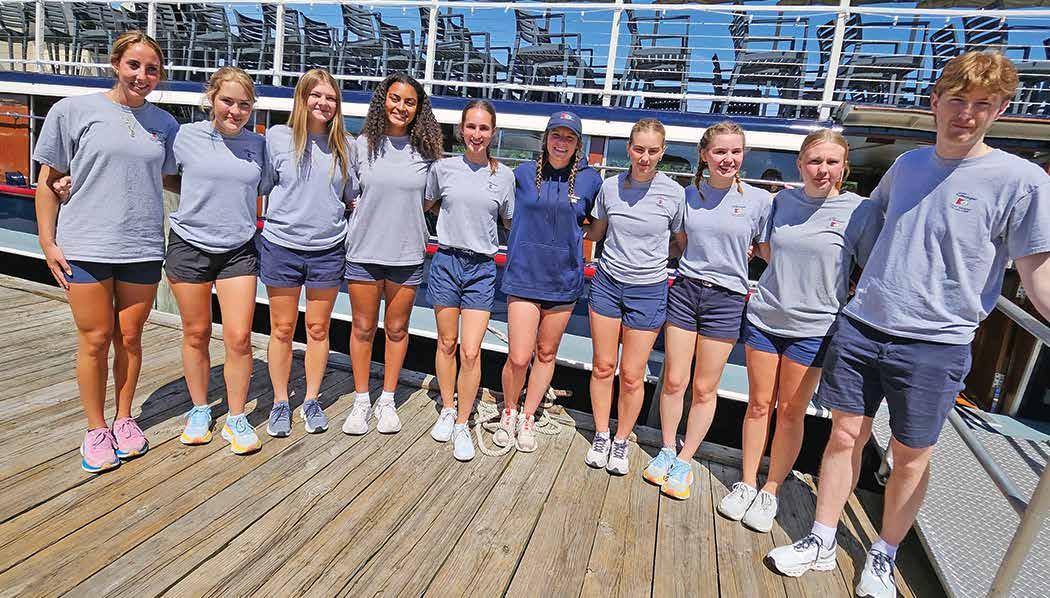
by Sandra Landen Machaj
CORRESPONDENT
One morning earlier this summer, the Walworth, also known as the U.S. Mailboat of Lake Geneva Cruise Line, began a cruise on Geneva Lake. The Walworth usually leaves at 10 a.m. when delivering the mail, but on this day, it was on a special journey.
This was the day when the prospective applicants were auditioning for the job of mail jumper for this summer. A total of twelve gathered in the front of the boat, ready to display their skills.
They seemed to be familiar with each other and were sharing stories as well as concerns about the day. To become a mail jumper is not just a question of jumping, but also performing other needed tasks during the cruise. The mail must be sorted, as there is no time to do so while they are delivering the mail and moving from pier to pier.
In addition to delivering the mail, the jumper must also read some of the live narration about the growth of the Lake Geneva area, especially pointing out the special summer cottages –mansions of the rich and famous – along the shore of Geneva Lake. The job of narration is shared by the mail jumpers, when not jumping, and the Captain. The homes of well-known families are identified – such as the Wrigley Compound, which has six homes currently on its estate.
So, on this day, the applicants took turns reading the history. Some had done this before, as they had previously been mail jumpers. The judges listened and graded them.
“Being a mail jumper is the most sought-after job,” said Ellen Burling, general manager of Lake Geneva Cruise Line. “In order to try out for the job, you have to have worked for the Cruise Line for at least a year. Each year, the jumpers reapply for the job. Being a mail jumper one year does not guarantee you will be chosen the next year.”
Like many Lake Geneva Cruise Line employees, Ellen is a past
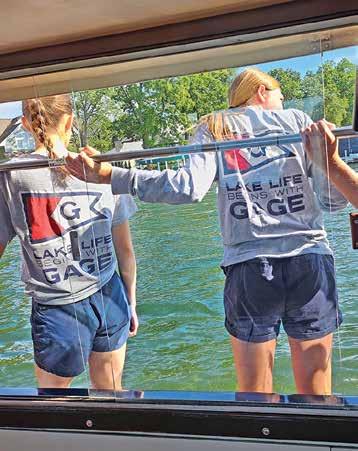
above: The entire group trying out made their way onto the side of the boat before all jumping onto a pier and running as a group along the prairie path. After running some distance on the path, they gathered on a different pier to be picked up by the boat. top: After tryouts for this year’s team of five mail jumpers, the applicants gather as a group outside The Walworth to commemorate the experience.
SANDRA LANDEN MACHAJ Lake Living

mail jumper, having held that position in 1984. Being a mail jumper is often a family affair. Ellen’s sister was a mail jumper, as were her son and daughter.
For most people, grabbing their mail means opening the front door and pulling it out of the mailbox, or walking down the driveway to the postal box along the road where the mailman deposits their mail each day. But for those who live on Geneva Lake, there is another alternative, which is to have their mail and newspaper delivered by boat onto their pier.
Beginning over 100 years ago, receiving the mail on the pier was the only way to receive it, as there were not any roads around the lake for delivery of mail. Everything else from building materials to food supplies arrived by boat as well. Boat arrival was also the way the residents were transported to their homes on arrival.
This was only done in the summer, as these “summer cottages” were for the most part not insulated or built with furnaces to allow occupancy year-round. On the first cool days of fall, the owners packed their belongings and returned to the city.
It was in 1916 that the idea was suggested that delivering the mail by boat could be made much more exciting if they added mail jumpers to leap off the boat, deliver the mail to the mailbox on the pier, and return to the boat and jump back on before it finished passing the dock without stopping.
At the time, the mail jumpers chosen were all athletic, long-legged men, who were thought to be able to handle the jump from the boat over the 4 to 8 feet of water between the boat and the piers.
This went on until 1974, when Elaine

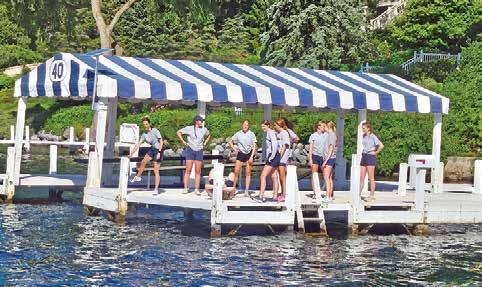
Kanelos decided she needed a summer job, and she was determined to be a mail jumper. Living on Geneva Lake and collecting the family mail each day in the summer, she chose to go right to the top. Kanelos sent a letter to Bill Gage, Sr., – head of the Gage Marine Boat Company, as it was called at the time – and told him of her desire to be a mail jumper. Much to her surprise, three weeks later she received a positive response from Gage and was given a job. Her first day on the job also served as her tryout. She passed the tryout and successfully delivered the day’s mail. Over the next 10 years, many more women have made the cut.
According to Ellen, there was one point where all of the mail jumpers were women. Today, everyone is welcome to apply. It
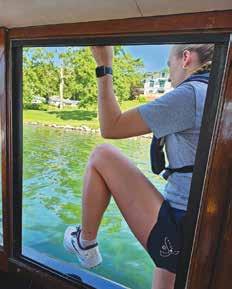
varies, but this year only one young man tried out while the rest of applicants were women.
While the Walworth normally has 150 passengers aboard to view this unique way of delivering mail, on tryout day, only a few invited guests were allowed on the boat.
First, there was a group of judges – many who were mail jumpers themselves in the past – who would be scoring the jumpers as they made their jumps and did their readings.
Also aboard were a few members of the press and some honored guests, including a 5-year-old who is determined to be a mail jumper when he is older and was wearing his mail jumper shirt proudly.
Bruce Pett, who was a mail jumper 60 years ago, returns every few years to watch the tryouts.
All of the young people trying out this year are enrolled in colleges all over the country, but in the summer, they return home to Lake Geneva. Many of them have been employed at Lake Geneva Cruise Line for several summers, and some have been mail jumpers for as many as three years, while a few were hoping to make the cut this year for the first time.
“I was able to jump twice last year, and it was truly one of the best days of my life,” shared Mia Fiscelli. “I have lived on Geneva Lake my whole life, and being a mail jumper has always been a dream of mine. I love giving the tour and talking about the history of the lake.”
Mia also said jumping onto the pier is the easiest part of the job.
“It is jumping back to the boat that is more difficult. There is more timing required,” she explained.
Mia attends the University of Colorado and is active in ice hockey and lacrosse.


139 Lance Dr, 302, Twin Lakes - Located on the 3rd floor of Lake Mary Resort, you’ll find this turn-key 4 BD, 2 bath unit with boat slip, offering spectacular lake views from your private balcony. Inside offers living room with fireplace and sliding glass door to the balcony, eat-in kitchen with breakfast bar and large dining area, master ensuite, plus 3 more bedrooms and full bath. Large laundry room as well. Lake Mary Resort offers a sand beach, indoor pool, underground parking and private storage on pool level for easy access to water toys & life jackets. Watch the ski show from your unit and short walk to downtown shopping and restaurants. Move in ready with the ability to accommodate a quick closing. $558,700

W1260 South Shore Dr, Palmyra - Your lakefront search stops here with spacious 5 BD, 2 full, 2 half bath move in ready 2 story with walk-out lower level with 65’ frontage on Blue Spring Lake. Lakeside kitchen with breakfast bar and large dining room with access to deck offering extended lake views. LR with cozy fireplace, main floor Master BD ensuite with sitting room lakeside. main floor laundry room. Upstairs offers 4 bedrooms and a full bath. Lower level Rec Room with sliding glass door that leads you to the lake. Lakeside level lawn and shed. Spacious back yard ideal for entertaining with multi-level patio. 2.5 detached garage with lower level storage. Blue Spring Lake is a All Sports Lake featuring crystal clear water in a North woods setting minutes to Kettle Moraine hiking, biking and SERENITY! $759,700
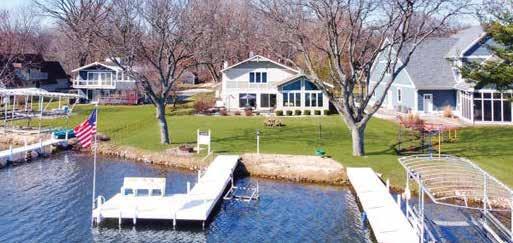
W5369 Baywood Dr, Elkhorn - Welcome to your home that’s surrounded by lake views, a large yard for family fun as well as plenty of parking for everyone. Enjoy amazing 4th of July fireworks with the best seats in the house. Situated on 103’ of level frontage on 0.81 of an acre, you’ll find an updated, move in ready, 4BR, 3BA, two story home with upper end finishes. The large vaulted ceiling kitchen has an adjacent dining area & bonus playroom/den. The family room, also with vaulted ceilings, features a wall of windows that welcomes the lake inside. The living room with a natural fireplace and sliders leads to a spacious brick patio. This home offers the privacy of a main floor primary bedroom and the upper level has 3 generous sized bedrooms and 2 full baths. Accommodates 19 guests. $1,999,700





300 W Main St, 111, Palmyra - Located downtown Palmyra you’ll find this Turnkey established Restaurant/Bar and separate 4 lane bowling alley waiting for an energetic entrepreneur to bring their vision to life. Restaurant/Bar has a seating capacity of 173 with an updated kitchen in 2019. Charming bar area overlooking main street and soaring ceilings in the dining area. Potential outdoor space for a beer garden and additional space to expand the bar area or rental opportunity. Income producing apartments on the second floor which consist of a 3 Bd, 2 Bd and 1Bd currently rented. Liquor license included. Palmyra is in the heart of the Southern unit of Kettle Moraine Forest offering hiking, mountain biking and equestrian trails. Minutes from Blue Spring Lake and steps to Lower Spring Lake. $695,000

W5135 Sterlingworth Ct, 13, Elkhorn - Prime location at the Sterlingworth Condominiums in the atrium, is just the beginning with this 2 Bedroom, 2 bath unit, steps off the beach with boat slip. The lake welcomes you as you walk in the door and head to the wall of sliding glass doors that leads to rare expansive deck. Eat-in kitchen with breakfast bar and dinette, living room with gas fireplace, large master bedroom with updated bath featuring walk-in multi-head tile shower and double vanity. Wood flooring throughout. Located right off the clubhouse with easy access to indoor pool. Tennis and Pickle Ball Courts and they finest sand beach on the lake. Short walk to Lauderdale Golf Course and minutes to Kettle Moraine trail head. Turn-key allowing for an easy transition to the lake! $759,700

W1411 N Blue Spring Lake Dr, Palmyra - Just completed in 2021 this spectacular Craftsman style 5 BD, 3 bath ranch situated on 100’ of level frontage on crystal clear Blue Spring Lake. Inside you’ll appreciate the owner’s attention to detail throughout with lake views from every room. Kitchen features granite counter tops, island/breakfast bar, Bosch appliances and dining area with access to lakeside covered deck. Ktch is open to LR with stone gas fireplace Master BD ensuite with dream bathroom, LL family room with amazing wet bar plus 4th and 5th bedrooms and fitness room. Main floor has Hickory hardwood floors and hand-stained Maple doors, panels, molding and trim. Throughout the house you’ll find hand-stained Amish Cabinets. Wet-boat house and permanent pier. Plus 1,200 sq ft 4 car garage. Municipal sewer with private well. $2,189,700
She has finished her first year on the hockey team in Colorado and was ranked in the top 10 for rookies in Division 1 of the American College Hockey Association.
Annie McEneany, a student at the University of Wisconsin working on a degree in special education, has been working for Lake Geneva Cruise Line for the past four summers.
“This is the best job ever,” she said while waiting for her turn to jump. “I was a mail jumper last year and loved it. My sister, who is six years older, was a mail jumper, too, several years ago. Working with Captain Ames is fun, as he was my band teacher in middle school.”
As the applicants prepared for their jumps, they were called by name, made their way to the window near the front of the boat – which was opened for them to climb out of, stand on the ledge, and, as the boat approached the pier, make the jump.
Each jump is unique, as the placement of the mailbox varies. Some are placed at the front of the pier, meaning they must jump, stop their forward momentum, and grab the mailbox without being catapulted down the pier.
Some piers require running to the back (closer to the shore) of the pier to the mailbox, zigzagging through the personal belongings of the homeowner that may be scattered on the pier.
Then, there is the return trip to the boat and the leap onto the ledge at the back of the boat before it passes by. Once back on the boat, they are not in the clear yet. They then have to walk or run the ledge back to the front window to grab the next batch of mail for the pier to be delivered to next and be ready to jump again before it’s too late.
Captain Ray Ames replaced Captain Neill Frame in 2019. Like his predecessor, Ames is a people-person who enjoys working with the jumpers as well as the visitors. Ames can be found piloting the Walworth seven days a week throughout the summer.
“Mail is delivered six days, and the newspaper is delivered all seven days, no mail on Sunday,” Ames said. “We currently have 75 homes with a Lake Geneva mailing address that choose to receive their mail on their piers from June 15 through Sept. 15.
“Our mail jumpers show their athleticism as they leap from the boat to the pier, race to the mailbox, take out any outgoing mail or packages, insert the day’s mail, and race back to the boat before I pass the pier.
“Sometimes they don’t quite make it and we have to return to pick them up. Occasionally, they miss the boat and end up in the lake,” he added.
Landing in the lake on a very hot day is enjoyed by the jumper as a way to cool down. Sometimes the falls are to provide excitement for the boat riders. A planned
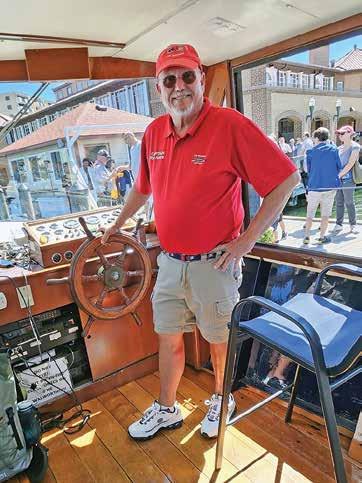
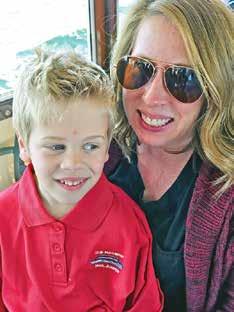
spill in the lake is always safer, as the captain will move the back end of the boat out a little so the back propellers are away from the jumper, and they don’t have a chance of being pulled into the wake created by the boat.
Falling into the lake accidently is quite rare, as this crew jumps to (and from) 75 piers each day. But an occasional fall is a good cool-off and brings excitement to a sleepy crowd.
at left: Captain Ray Ames, shown after docking The Walworth near The Riviera in Lake Geneva, became captain of the mailboat tours in 2019 after the retirement of Captain Neill Frame, who handled the duty for more than 40 years. below left: Hudson Huidobro, 5, shown with his mom, hopes to be a mail jumper when he’s older. He became enamored with mail jumpers after taking his first tour on The Walworth, and even dressed as a jumper for Halloween last year. below right: Ethan Connelly makes the jump back onto the boat during tryouts, landing on the narrow walkway. From there he walks to the front and reenters through the window.
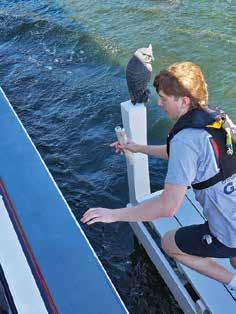
After over two hours of tryouts, the boat returned to the pier at the Riviera. But these prospective jumpers were not finished, because the boat needed to be readied for a tour of the Lake, which was scheduled to leave a half hour later. It was the applicants who were given the job of
• CONTINUED ON PAGE 18
By Valerie Streif CONTRIBUTOR
Do you dream about getting on the water every weekend during the summer months? Are you looking for a new way to bring your family together while enjoying the outdoors? Have you always wanted to own a pontoon to be able to provide a fun space on the water for your favorite people?
If the answer is yes, and buying a pontoon is on your radar, we’ve got all your questions and concerns covered.
Pontoons are one of the most popular choices of pleasure craft, thanks to their comfort and versatility. You can enjoy almost any activity on a pontoon — sunbathing, fishing, and water sports like tubing — and there’s plenty of space onboard for all passengers to be comfortable. They are also great for exploring, since you can easily beach a pontoon on a sandbar or remote beach for a camping trip.
Need to stop for a swim? A pontoon’s swim ladder will be easy to climb back on the boat, and many pontoons have ample storage space for stashing your floating mats and inflatables once you’re back to cruising.
Purchasing a boat is a huge decision, and there are plenty of considerations to take before you hand over the money. Of course, you’ve got to take your own personal circumstances, budget, logistics, and more into consideration, and we can’t make a firm recommendation one way or another, but if you’re weighing your options, here are some of the reasons on either side that we’ve found to be true.
• Smooth cruising – often considered the SUV of the water, a pontoon offers a stable and smooth ride. That’s because the boat’s weight distribution across the ‘toons provides extra stability when cruising on rough water, and as a result, pontoons rarely capsize.
Their wide turn radius, while an objective limitation, actually results in a smoother overall ride when you’re not trying to turn on a dime – perfect for cruising with small children or elderly folks. They also often have features like nosecones and wave tamers that act like shock absorbers, so you won’t feel the impact as you cruise over small waves and chop.
• Family friendly – a pontoon for families of any size will provide the best atmosphere for most everyone. Pontoons have high railings to keep small children contained, plenty of space for teenagers to bring their friends on board, and the ability to tow kids for fun water sports.
It’s a great multi-generational boat, too, because it’s very easy to board for older family members, and grandma and grandpa
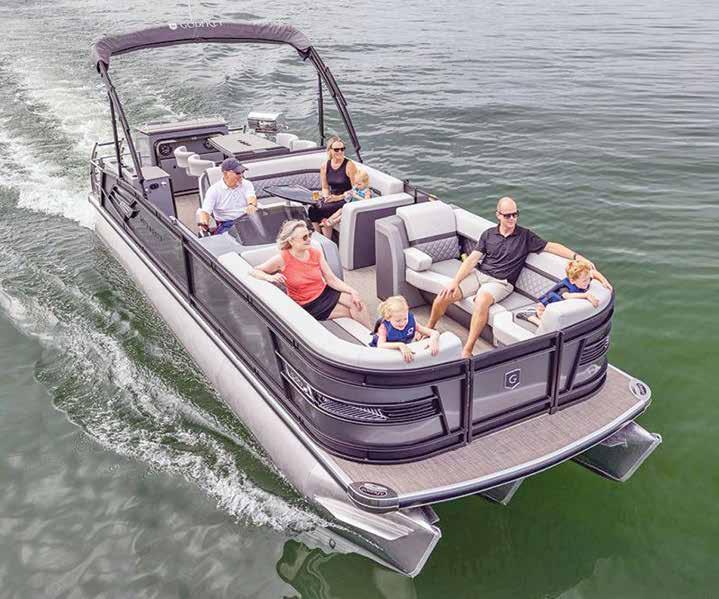
will appreciate the smooth ride.
• Versatility – while pontoons don’t necessary excel at any one specific type of water, the benefit is that it’s a great all-around pick for just about anything you’d want to do out on a casual boat day: water sports, fishing, lounging, picnics, or exploring remote areas.
Because of their open design and spacious seating, they’re also great for hosting an event on the water and getting together with your favorite people.
• Easy to maintain – because pontoons are powered by outboard engines, they are easier to service and require much less maintenance than inboard motors and other styles of boats. As long as you properly winterize your pontoon, you shouldn’t need to do too much maintenance or upkeep to have it running smoothly.
It’s also very easy to clean. You can hose off most surfaces and easily wipe away any mess that is made while having fun on the water.
• Water sport limitations – while you can have some fun on tubes or water skis with a pontoon, you can’t do everything as well as a standard power boat, due both to a combination of speed limitations and the type of engine. The max speed on pontoons is typically around 40 mph, with most boats
operating between 28–35 mph.
The wake is also wider, which is less ideal for wakeboarding. But most importantly, wake surfing should never be done behind a pontoon — since they have outboard engines, riders would need to be unsafely close to the motor to wake surf.
• Bad weather limitations – storms with high winds and large waves are dangerous for any boat, but especially a pontoon. Without a V-shaped hull, they can’t cut through high waves effectively, so in a bad storm, pontoons are easily swamped in these conditions.
Don’t go out on your pontoon if there is a storm risk, and of course, always be vigilant about changing weather patterns when out on the water.
• Wide turn radius – due to their wide turning radius, pontoons might be tricky to handle for new boaters, so it’s a good idea to practice in safe conditions and always be very cautious when docking or navigating in a tight space.
• Depreciation – if you plan to own a boat for only a few years and then resell it, a pontoon might not be the best choice for you. While any boat loses its value after the initial purchase regardless of style, pontoons lose their value faster than a lot of other types of boats: about 25% of the resale value after just a couple of years of ownership. This depreciation is because there is less


demand for older pontoon models in the used boat market, and because pontoons are often used more frequently than other types, it’s assumed there is more wear-and-tear on them than other styles.
This isn’t a problem if you plan on having a pontoon boat for life, but it is something to consider if you’re not sure how long owning a boat will be a part of your lifestyle.
Pontoons can range dramatically from simple, budget-friendly models to luxurious vessels with state-of-the-art features and high-performance engines, so of course, there’s a huge range in prices. On average, a mid-market pontoon will generally cost somewhere between $18,000 and $60,000.
If you want to spend as little as possible, you can often find used options from a boat dealer for as little as $15,000. However, with cheaper and older models, it’s a good idea to have a professional boat mechanic inspect it before you commit to buying.
On the more expensive side, luxury pontoons from a top manufacturer will cost well over $100,000 – some even closer to $200,000 when they’re customized with special amenities like waterslides, grills, and luxurious features.
If you plan on owning your pontoon boat for a long time, buying a new one might be a better decision, since you can enjoy the manufacturer’s warranty and be assured that you’ve done the proper upkeep and maintenance. With a used boat, you run the risk of issues caused by the previous owner that could be costly down the road.
In addition to the purchase price of a pontoon, plan on spending between $2,000$5,000 extra annually for repairs, storage, and other expenses, like:
• Insurance – while boat insurance is not always a mandated requirement or a state law, insuring your boat is highly, highly recommended to cover yourself in case of damages to your boat or injuries to others when out on the water.
The annual cost for boat insurance ranges between $150-$400 annually, but this can be higher depending on the level of coverage and the condition and year of your pontoon. Check out our partner at Boat Charter Insurance for their great rates and offerings for insurance.
• Taxes, title, and registration fees – these expenses will vary from state to state and country to country. You’ll want to see what you’ll need by visiting your state’s DNR website and researching the fees for your pontoon registration.
• Marina and docking fees – if you don’t own waterfront property with a dock where you plan to store your boat and don’t want to deal with the hassle of trailering your boat every time you use it, you’ll need to explore options for docking at a marina. Marinas can cost anywhere from $2,000 to over $15,000
annually for a docking slip depending on the local area’s demand and exclusivity.
• Maintenance – despite the efforts of even the most cautious boat owners who take great care of their vessels, pontoons that are frequently used, hauled around, and enjoyed will experience wear and tear. Annual maintenance costs for a pontoon owner will vary depending on many factors, but you should expect to spend a minimum of $1,000 annually on basic maintenance.
• Fuel – the frequency with that you use your pontoon will determine your fuel costs, but overall the cost to fill up a pontoon with gas ranges between $150-300 depending on the size of the pontoon’s tank. This cost can fluctuate since local fuel dock prices can change without warning, so it’s best to set aside some extra cash in your pontoon fuel account.
• Accessories – other costs that you’ll need to expect when you first buy a pontoon are the essential accessories, including a trailer, safety gear for onboard - like a first aid kit, lifejackets, other floatation devices, an anchor, ropes, and lines - and a boat cooler for keeping your drinks and food cold when out on the water. While these are all much smaller expenses than the cost of the boat, they do add up to a significant price when you’re first starting out.
Now that you’ve got your beautiful pontoon, you’ve got to take proper care of the thing. Routine maintenance and upkeep will help prevent mechanical issues and ensure you get as much quality time on the water with your pontoon during every boating season.
– Always cover your pontoon when it’s not in use. Whether that involves a shaded dock slip or pulling a fitted cover over the boat, keeping your pontoon’s interior covered when it is docked is crucial to prevent fading of the interior cushions.
You’ll also want to keep rain and bugs out, so a fitted cover is ideal, even if your dock slip is covered.
– Winterize your pontoon properly and, ideally, store it indoors. Climate-controlled storage will help preserve your pontoon and prevent damage caused by freezing and expanding liquids.
– If you’re boating in salt water, be sure to flush the engine after every time you’re on the water. Prevent corrosion and salt buildup by periodically cleaning the bottom of your pontoon.
– Regularly check for any leaks or dents in your boat. Finding a leak early can help prevent costly damage. Thankfully, pontoons are less susceptible to damage on the hull due to their ability to cruise in shallow waters, but you can still end up bumping into obstacles in the water, which would be cause for concern.
For information on the maintenance of your boat, check out our guides on how to fix a drowned outboard engine, avoid stainless steel corrosion, and care for boat surfaces.
Is buying a pontoon worth it? It depends on the individual user, obviously, but doing your research, calculating all the expenses, and comparing them to your budget is essential. And we think the best way to research pontoons is to experience them firsthand — by renting them out and testing different makes and models.
Just like test driving a car, you’ll want to test drive a boat before you buy it, and it’s even better when you can make a whole boat day out of your test drive!
On Getmyboat’s website, you can find pontoon rentals you can drive yourself to get the full feel and experience.
For more information, visit getmyboat. com.
Valerie Streif, marketing manager for Getmyboat, is a communications specialist for the world of boating.

Sugar Creek Mutual Insurance Company
Elkhorn 262-723-3244
Banco Insurance Agency
Palmyra 262-495-2118
Whitewater 262-473-7334
“Ichoosemutualinsurance becauseiknowwe’re inthistogether.”
Breck Ward
Elkhorn 262-215-5633
“Ichoosemutualinsurance becauseiknowwe’re inthistogether.”
“Ichoosemutualinsurance becauseiknowwe’re inthistogether.”
Patricia Lauderdale
Elkhorn 262-742-3818
Daniels Insurance Agency
Burlington 262-537-2677
Policyholders
Grams Insurance Agency
Policyholders who work with a mutual insurance company have a shared purpose: getting the best coverage and protection available. And mutual insurance delivers because mutuals serve policyholders, not shareholders. Our decisions are always based on what’s best for you. Plus local agents offer customized solutions for all your insurance needs. Find out how mutual insurance can work for you.
Policyholders who work with a mutual insurance company have a shared purpose: getting the best coverage and protection available. And mutual insurance delivers because mutuals serve policyholders, not shareholders. Our decisions are always based on what’s best for you. Plus local agents offer customized solutions for all your insurance needs. Find out how mutual insurance can work for you.
Edgerton 608-884-3304
Evansville 608-882-6515
Schaal Agency LLC
Waterford 262-534-7801
because mutuals serve policyholders, not shareholders. Our decisions are always based on what’s best for you. Plus local agents offer customized solutions for all your insurance needs. Find out how mutual insurance can work for you.






Whether it’s a taste preference or as a result of looking to eat healthier, many people choose fish as a regular main dish for their meals.
Fish and other seafood may not be part of “normal dietary routines” for some, and that can lead to uncertainty regarding how to prepare and cook them.
The following tips can set the course for success when cooking fish.
• If preparing fresh fish just caught, this won’t apply, but for others, and as a reminder, seafood should have a mild, fishy aroma. If it is overpowering, the fish may be spoiled.
In regions where fish has to be transported inland great distances instead of having access to freshly caught fish, it may be best to purchase frozen fish so it’s less likely to be past its prime.
• Most fish is fully cooked when the center is opaque and the fish flakes easily with a fork.
Fish can be cooked a variety of ways – fried, poached, steamed, baked, or grilled.
• Baking fish is one of the easier methods to master, particularly for those who are prone to overcooking fish.
Set the oven to 450° F to cook the fish quickly and evenly. Thin fillets need around 8 minutes, while thicker cuts may require 15 to 20 minutes.
• Resist the urge to manipulate the fish too much; otherwise, it will fall apart since it is very delicate. Try to flip only once.
• Pat the fish dry before
cooking, as extra moisture can cause the fish to steam instead of sear, resulting in a mushy final product.
• Choose the right fish for the recipe. For example, a chowder or paella will require a more sturdy fish, such as cod, while a more delicate fish will fall apart if simmered.
• If you want crispy skin on fish, start it in the pan with the skin side down. Be careful not to flip it until the skin stops sticking to avoid breaking the fish apart.
• Choosing a variety of seafood in a recipe might mean managing different cooking times. Investigate the ingredients and figure out when to add them to the mix.
Shrimp or mussels, for example, cook rather quickly, so they tend to be added during the final phase.
• For those who will be frying fish, make sure not to overcrowd the pan so that the temperature remains consistent and will produce crispy results.
• Watch for bones. Some fish, including trout and salmon, have a double rib cage, and that means small pin bones. Remove the bones by pressing the flesh with your fingers and using a tweezer to grab the pin bones.
• For more professional flipping results, purchase a fish spatula, which can get underneath fillets without tearing them apart.
This advice can put anyone on the road to successful fish preparation.
(METRO CREATIVE)
Total time: 25 minutes
Yield: 4 servings
This baked fish recipe is the opposite of fussy. Use fresh or frozen fillets for a quick and simple dish that pairs well with almost anything for a perfect weeknight (or any night) meal.
Ingredients
1-1/4 pounds fish fillets
1 teaspoon seasoned salt
Pepper to taste
Paprika, optional 3 tablespoons butter, melted Optional: fresh dill and lemon
Total time: 1 hour
Yield: 12 tacos
Ingredients
Fish:
2 pounds white fish, like tilapia, cod, rockfish or halibut
1/4 cup olive oil
1/4 cup fresh lime juice
2 teaspoons chili powder
2 teaspoons ground cumin
1 teaspoon garlic powder
1 teaspoon smoked paprika
1 teaspoon coarse kosher salt, use a bit less if using table salt
1/8 teaspoon cayenne pepper, more or less to taste
Sauce:
1/2 cup sour cream 1/2 cup mayonnaise
3 tablespoons fresh lime juice
1 teaspoons sriracha sauce
1 teaspoon garlic powder
Tortillas and toppings: 12 (6-inch) corn or flour tortillas
Finely shredded cabbage
Fresh cilantro
Diced avocados
Pico de gallo (see note)
Cotija or queso fresco cheese
Lime wedges
Directions
Place fish in shallow dish or Ziploc bag.
Whisk together the olive oil, lime juice, chili powder, cumin, garlic powder, smoked paprika, salt, and cayenne. Pour the marinade over the fish and gently toss to coat all sides of the fish. Cover and place in the refrigerator to marinate for 30-45 minutes.
For the sauce, whisk together all the ingredients until well-combined. Refrigerate until ready to
Directions
1. Preheat oven to 400°. Place fish in a greased 11x7inch baking dish. Sprinkle with seasoned salt, pepper, and, if desired, paprika. Drizzle with butter.
2. Cover and bake until fish just begins to flake easily with a fork, usually 15-20 minutes. If desired, top with additional butter and fresh dill and serve with lemon wedges.
Recipe courtesy of tasteofhome.com.
use. The sauce can be made several days in advance. While the fish marinates, prep/chop the toppings.
Cook the fish using a grill, air fryer, oven, or stovetop. Timing will depend on the thickness of the fish and exact temperature. Keep a close eye on the fish and cook until it easily flakes with a fork and is no longer translucent/raw in the center. An instant-read thermometer should register 140 degrees F at the thickest part.
Grill: preheat a grill to medium-high, lightly oil the grates (or use a grill basket), and cook the fish for 2-3 minutes per side.
Air Fryer: preheat an air fryer to 370 degrees for 2-3 minutes. Lightly grease insert of air fryer. Add fish in a single layer and cook for 6-7 minutes.
Oven: preheat oven to 375 degrees F. Line baking dish with aluminum foil and lightly grease with cooking spray. Add fish in a single layer and bake for 3-5 minutes per side.
Stovetop: heat 1-2 tablespoon olive oil in a large nonstick skillet over medium heat. Add the fish in a single layer (don’t crowd the pan; may need to cook in batches) and cook for 3-4 minutes per side.
After cooking, season to taste with additional salt and pepper.
Serve the fish on warmed corn or flour tortillas piled high with toppings and drizzled with sauce.
Recipe courtesy of melskitchencafe.com.
The Wisconsin Department of Natural Resources regularly issues reminders for boaters to stop the spread of invasive plants and animals.
The Great Lakes Landing Blitz is a collaboration of the Great Lakes states and provinces that aims to teach boaters that simple clean-up steps and draining water from the bat and live wells can help prevent the spread of aquatic invasive species.
“We can all make a difference, whether we are enjoying the water with a fishing or recreational boat, jet ski, or paddle craft,” the DNR wrote in a news release.
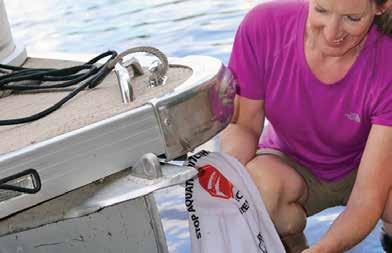
The collaboration’s annual event was held earlier this month and featured volunteers and regional aquatic invasive species prevention partners greeting many Wisconsin boaters at landings and access points.
Clean Boats Clean Waters boat inspectors gave out boat trailer stickers with a graphic showing where plants, tiny animals, and potentially contaminated water can hide on a boat and trailer.
“It only takes a minute to remove plants, animals, mud, or debris from boats, trailers, and equipment and to drain all water from bilges, livewells, and bait buckets,” said Erin McFarlane, the Statewide Clean Boats

Steph Boismenue works to clean a boat in an effort to prevent the spread of aquatic invasive species. The DNR regularly reminds boaters to help stop the spread.
Clean Waters Educator with Extension Lakes.
“These simple steps help keep invasive species from hitching a ride from one lake or river to another,” McFarlane added.
Every boater and angler has a role to play in protecting Wisconsin’s lakes and rivers. All who take to the water are reminded to follow these prevention stepsrequired by Wisconsin law - to help prevent the spread of aquatic invasive species in local waters:
• Inspect boats, trailers, and equipment before and after use.
• CONTINUED ON PAGE 18



By Jennifer Eisenbart STAFF WRITER
A new trend in boating has created a need for new rules on area lakes.
Wake-enhanced boats – also known as wake surf boats – are boats that use ballast tanks, water sacks, or fins to cause a boat to operate in a bow-high manner.
That, in turn, makes the wake behind a boat bigger for tubers, water skiers, or wake boarders being pulled behind the boat.
However, numerous different authorities throughout the state have begun to see the impact these boats have on lakeshores –mainly shoreline erosion, destruction of fish habitats, and damage to lake bottoms.
Wake-enhanced boats also create hazards for other boaters, kayakers, swimmers, paddle boarders, and pleasure boaters.
Because of the use of ballast tanks, which cannot completely be drained, there is also the concern of invasive species being transferred from one lake to another.
The maximum depth of Lauderdale Lakes is about 54 feet, and most of the lakes in the chain are narrow – a total of 825 acres for all the lakes.
According to Lakes at Stake Wisconsin, restrictions have been suggested for small and medium lakes for the following reasons:
• Large lakes are better resourced to monitor for invasive species.
• Most Wisconsin glacial lakes are irregularly shaped, with bays, kettles, and critical habitat areas needing protection.
• The solution to pollution is dilution, which means that small and medium
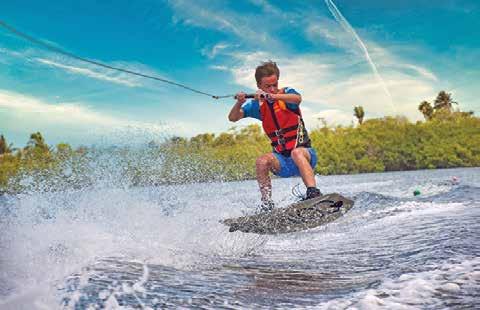
sized lakes are exponentially impacted by resuspension of bottom silt.
• Many lakes have sunken islands, bars, and reefs that come up to shallow depths, which in turn make them prime areas for fish habitats. They are also harder to navigate around with smaller and irregularly shaped lakes.
• The wake sports industry recommends that these boats limit repetitive passes against a single shoreline, which is more difficult with small and medium sized lakes.
Lakes at Stake has been working in the
last year to put regulations in place for such boating activities.
According to an article on WisBusiness. com, the group is led by Paul Gardetto, a 29-year veteran of the U.S. Air Force who owns lakefront property in Waukesha County.
In the article, Gardetto stressed that the group doesn’t want to ban the boats, but instead limit the activity to larger lakes.
Numerous municipalities, lake authorities, and organizations – both in the state and outside of it – have begun taking a stance against wake-enhanced boats.

The Wisconsin Department of Natural Resources recently announced that data from the annual spring survey of breeding waterfowl is available. The survey indicated both stable population numbers and habitat conditions for migratory birds.
The information from this survey is part of the overall survey of breeding waterfowl in North America. It aids the DNR in making management decisions about waterfowl in Wisconsin, including hunting season structure and harvest limits.
The spring waterfowl breeding survey has been conducted every year since 1973, except for 2020. Survey results are best interpreted as trends over several years rather than year-to-year comparisons.
Surveyors estimated the state’s breeding duck population to be 502,058 birds, a 3.7% decrease from the 2023 estimate but
above the long-term average. The mallard breeding population estimate is 146,561 birds, 7.9% lower compared to 2023 and lower than the long-term average. The wood duck population estimate was 96,711 birds, similar to last year and above the long-term average. The Canada goose population estimate was 153,402 birds, similar to 2023 and significantly higher than the long-term average.
“In addition to positive survey results, the wet conditions across the state should provide excellent brood-rearing opportunities for waterfowl throughout the remainder of the summer,” said Taylor Finger, DNR game bird ecologist.
Find additional data from this and other wildlife survey reports on the DNR’s Wisconsin Wildlife Reports webpage at dnr.wisconsin.gov/topic/WildlifeHabitat/ reports.
By Wayfair.com staff CONTRIBUTORS
When you think of lake houses, you usually picture relaxing days by the water. From a day of reading with your toes in the sand to a day of kayaking or boating with friends, your lake house is the perfect place to make long-lasting memories with loved ones.
Capturing your dream interior decor style for your lake house will not only make you feel more at home but can enhance the good times and memories created there. Whether you’re looking for a classic nautical design or something a bit more rustic, Wayfair has put together a list of ideas for your lake house interior design.
While darker woods are common in rustic lake houses, you can opt for a lighter wood (like white oak) for your main furniture to brighten up your lake house. A light wood base can keep your space feeling light and airy and enable you to opt for a lighter color palette throughout your lake house. Light wood is common in coastal homes. Look for furniture that is distressed for a lived-in, coastal twist on a rustic look.
Don’t forget to add a bench or other seating near your windows. A beautiful lake surrounds your lake house, and it’s the main draw for you, your family, and guests to enjoy. A bench or seat near the window is the perfect spot to enjoy your morning cup of coffee while looking out at a picturesque lake.
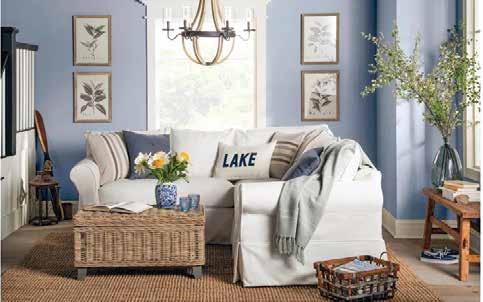
Give a nod to lake life by incorporating items traditionally used on the water, like kayak paddles or boat oars. This lake house design idea brings in the sense of adventure of your favorite lake activities while adding fun decor to your lake house.
If you don’t want to hang them on the wall, try adding them in the corners of the room or beside bookcases. It will add a fun and unexpected nautical twist to your decor.
Stripes are reminiscent of everything nautical and work perfectly in lakeside homes. They are an easy pattern for adding lake house details without overpowering the room with decor items.
Shades of blue, including navy, are perfect for tying in the color of the water, while the stripes, no matter the thickness, will give off
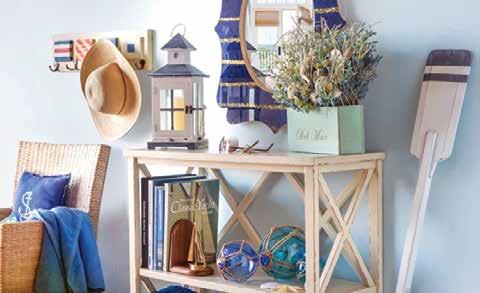
a nautical feel. Go bold and choose dining chairs with dark, navy stripes. The chairs will undoubtedly draw the eye and act as a focal point for your dining table.
If bold stripes aren’t your thing, don’t worry – look for smaller stripes in a lighter color to add that same lake house detail without overpowering the rest of the room. Add stripes to your walls using wallpaper in a light blue for a subtlety that still gives off that waterside feel. If you are looking for easy-to-install wallpaper, opt for striped peeland-stick wallpaper.
If there is any color that screams living by the water, it’s blue! Incorporating shades of blue into your lake house interior design gives it a nautical feel just by adding in that color. Look for different decor items, like glass balls or lanterns, in various shades of blue. It gives pieces that aren’t typically seen as nautical a lake house feel. Keep the rest of your color palette neutral to allow the blue to act as the pop of color in your space.
When it comes to lake house interior design, your walls are a great place to add
above: Soft, cozy blankets and pillow covers will add comfort to your sofa while adding a soft texture. Jute or sisal area rugs help add a rough texture to the floor while giving you a warm place to rest your feet. at left: Incorporating shades of blue into your lake house interior design gives it a nautical feel just by adding in that color. Look for different decor items, like glass balls or lanterns, in various shades of blue.
lake-inspired decor without crowding your space. Look for items that make you feel like you’re on the lake, like wall art with ropes, anchors, or even boats.
If you want to take your wall art to a more personal level, frame photographs of the lake itself or photographs of your family enjoying time on the lake.
A rope is a common material and tool used on most boats. Whether it is used to secure items on board or tie a boat up to a dock, rope is a material common to lake life.
Adding rope details to your lake house is an exciting way to incorporate that lake feeling into your interior design without defaulting to the typical anchors or shades of blue. The rope itself adds a fun texture to your space and can add to your overall decor. Look for a table lamp that uses rope as the base for an unexpected way to use a rope – guests are bound to love your attention to detail. Add a wall mirror with braided rope on the outside to create a cohesive rope look in the room and add more texture to your wall.
Turn your child’s room into a fun, lakeinspired bedroom. Look for bedding with boats on it to incorporate a nautical but playful theme. Opt for something linen or light so that they can get cozy without overheating on hot summer nights.
Add brightly colored pillows and decor items in shades of red and blue. This lake house interior decor idea is a fun way to decorate your little one’s room so that it can even be used as a guest room.
Texture adds interest to any room and is an excellent consideration if you choose to keep your color palette neutral. Look for various types of textured items that you can add to your space. Soft, cozy blankets and pillow covers will add comfort to your sofa while adding a soft texture.
Jute or sisal area rugs help add a rough texture to the floor while giving you a warm place to rest your feet. Compared to wooden furniture or a woven ottoman, smooth textiles will help balance out the rougher textures.
Traditional, dark wood furniture and decor items known for their rustic vibes (such as candle holders, coffee tables, and picture frames) can be perfect additions to your lake house interior design.
The rustic feel and dark colors of these objects are reminiscent of boats, docks, and lakeside forests, creating the ideal lake house vibe. The wooden furniture displays the details of the wood and adds an interesting texture to the space. Add wooden frames in a similar shade for a cohesive feel throughout the room.
For more of a moody feel, opt for a dark brown leather sofa, which will be
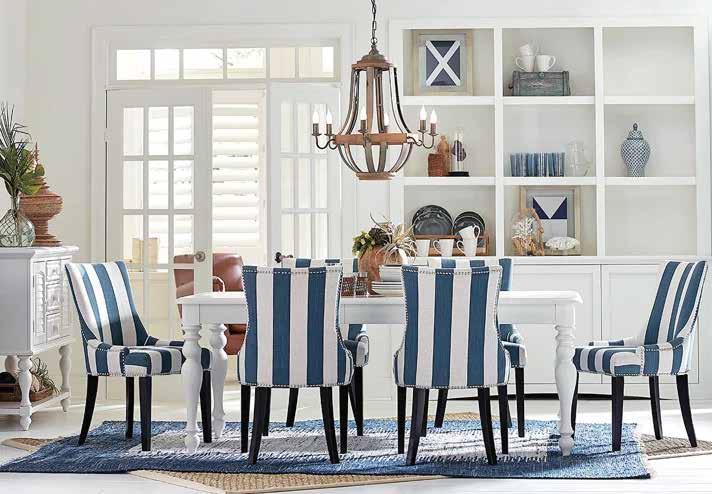
Stripes are reminiscent of everything nautical and work perfectly in lakeside homes. They are an easy pattern for adding lake house details without overpowering the room with decor. WAYFAIR.COM PHOTO Lake Living
comfortable to relax on after a day on the lake while offering a dark accent to the room.
Lake house interior design doesn’t have to be strictly nautical; try making it modern! Keep furniture slim and sleek to give off that modern feel while choosing lakeinspired colors, like light blues and grays, to incorporate the lakeside feel.
Look for sofas and chairs that show off their slim legs with curves and rounded edges to finish off the modern look. Frame a photograph of the lake in a sleek white frame to tie in lake-inspired decor.
If the traditional nautical feel isn’t your lake house vision, don’t worry! You can embrace a rustic lake house feel by adding different patterns throughout your home. Opt for patterns in dark or dull colors - so that the color palette isn’t too bright - to keep the home feeling rustic.
Pair patterned throw pillows with a dark leather sofa to offer some color, while the dark leather acts as a cozy rustic backdrop to your lake house decor. Lay a patterned rug in light colors to offset the darker shades on the sofa; this can help brighten the space while incorporating another pattern in the room.
A distressed coffee table will add to the rustic feel. The details on the wood add their own unique pattern to the room while showing off the natural details of the wood itself.
For a twist on the traditional nautical look, consider wooden decor items. Instead of a traditional bookcase, look for a bookcase in the shape of a rowboat. It offers shelving for
books and decor items while acting as a rustic decor piece itself.
Add wooden birds, foxes, and antlers around the room for a rustic spin on traditional lakeside animals.
When starting work on your list of lake house decorating ideas, don’t forget to take it outside. Add seating to your front porch to sit back and take in the view of the lake or enjoy a warm cup of coffee first thing in the morning.
Cozy additions like a hammock chair, outdoor rug, or outdoor throw pillows will bring the inviting feeling of your home to your porch.
Turn your lake house into a wonderland this winter by swapping out warm-weather decor for cozy elements. A wood stove helps keep you warm after a long day of ice skating or cross-country skiing across the lake. Add a basket for log storage to help keep the fire going while acting as extra decor in the room. Prop your skis nearby as a fun addition to your decor.
When it comes to textiles, go for cozy options like soft blankets and faux fur pillows, which can give you a reason to snuggle up on the couch while adding a sense of warmth and softness to your sofa. Showcase elements from the colder seasons, like pinecones, to help bring parts of the outdoors in.
Consider leaving your wintry decor up all year. Since lake houses can be used yearround, it’s not unusual to see skis, snowshoes, and even trail maps throughout the seasons.
For more lake house decorating and design ideas, visit wayfair.com.
8












replacing the seating that had been removed for the tryout cruise with traditional seating that will hold the expected number of guests.
In spite of the activity over the previous two hours, they were right at work, all still smiling.
The judges met after the tryouts ended to decide on who would be this year’s mail jumpers. According to Ellen, they were judged on a variety of points, including style and the stamina needed to complete the job.
“This was a very difficult group to judge,” said Burling. “Never have there been this many good choices.”
Yet those tough decisions had to be made and all five jumpers chosen for this summer have previous experience in the job.
This summer ’s jumpers are Marie Nickolette, Gina Weis, Marissa Torres-Raby, Ella Clapp, and Michaela Fletcher, according to Ellen.
The 2 1/2-hour cruise leaves the Riviera Docks at 10 a.m. each morning, loaded with mail, packages, and newspapers to be delivered to piers around the lake.
To purchase tickets for a Mailboat Cruise, which run through Sept. 15, visit cruiselakegeneva.com/public-tours/usmailboat.
14
• Remove all mud and attached aquatic plants and animals.
• Drain all water from boats, vehicles, and equipment, including livewells and fish buckets.
• Never move plants or live fish away from a waterbody
• Dispose of unwanted bait in the trash.
• Buy minnows from a Wisconsin bait dealer.
Additionally, only use leftover minnows when fishing with them on the same body of water. They can be used on other waters only if no lake or river water or other fish have been added to their container.
For more information about invasive species, visit dnr.wi.gov.








